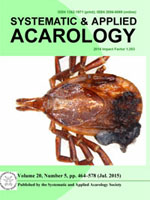The new species, Fortuynia dimorpha sp. nov. from the Philippine intertidal habitats shows a distinct sexual dimorphism. The posterior part of the gastronotic region is completely porose and some notogastral setae are conspicuously elongated in males. The specific function of this sexual dimorphism is yet unknown, but the found modifications are supposed to be involved in pheromonal communication allowing rapid sperm transfer during low tide. Fortuynia dimorpha sp. nov. is the third species of this genus displaying sexually dimorphic characters worldwide, but it represents the first case of sexual dimorphism found in the Indo-Pacific area, where most Fortuynia species are harboured. Based on a comparison of all known cases of sexual dimorphism in marine associated ameronothroid mites it is assumed that the sexually dimorphic characters of Ameronothridae possibly allow a special mode of spermatophore deposition in order to protect these unstable structures from disadvantageous environmental conditions, whereas the modifications in dimorphic Fortuynia species may be involved in some kind of associative mating.
How to translate text using browser tools
31 July 2015
An interesting case of sexual dimorphism in intertidal mites: Fortuynia dimorpha sp. nov. (Acari, Oribatida, Fortuyniidae)
Tobias Pfingstl
ACCESS THE FULL ARTICLE
<
Previous Article
|

Systematic and Applied Acarology
Vol. 20 • No. 5
July 2015
Vol. 20 • No. 5
July 2015
Ameronothridae
associative mating
Indo-Pacific
nymphs
porose areas




